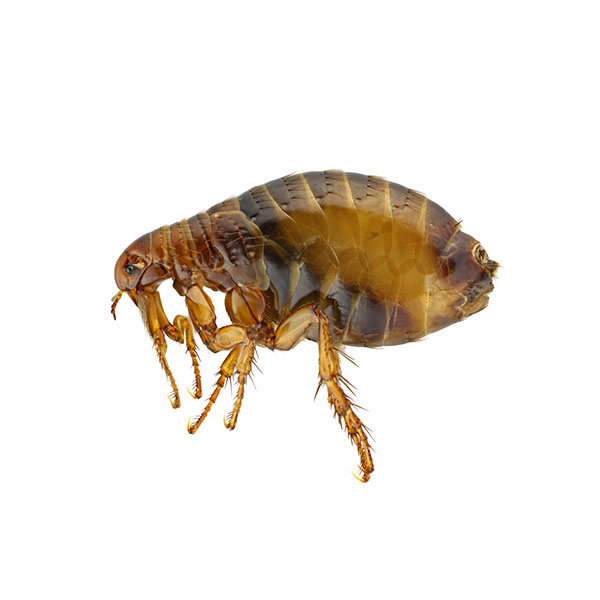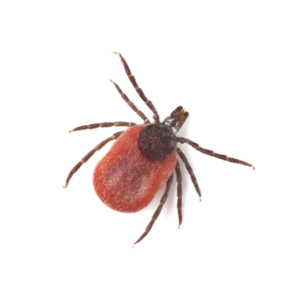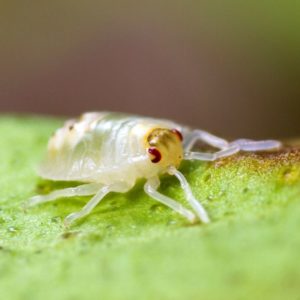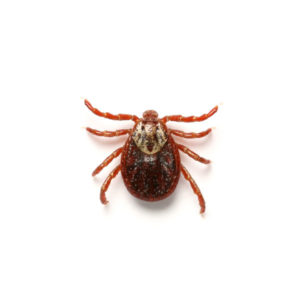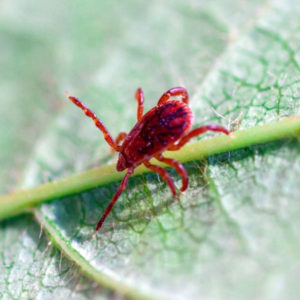Flea Identification
What Do Fleas Look Like?
Fleas are small, wingless insects with flattened bodies that are laterally compressed, allowing them to move easily through the fur or feathers of their hosts. They range in size from about 1 to 4 millimeters in length. Fleas are usually dark brown or reddish-brown in color and have long hind legs adapted for jumping.
Signs of a Flea Infestation
Signs of a flea infestation include pets scratching excessively, especially around the neck, back, and tail base. You might also notice small black specks (flea feces) on your pet’s fur or in bedding.
Flea bites on humans typically appear as red, itchy bumps clustered together on areas like ankles or legs. Seeing adult fleas jumping on pets or furniture is another indication.
Habitat, Diet, Life Cycle & Bites
Where Do Fleas Live?
Fleas thrive in many climates but prefer moist, humid, and shady areas. The area underneath a porch or deck can turn into an overwintering site. Areas with tall grass, leaf litter, weeds, wood piles, gravelly areas, and sandy patches are all attractive to fleas. Even the tiniest crack in the concrete can harbor fleas and they especially shrubs, leaves, and trees, but do not fare well in sunny areas or open grass. Fleas usually enter structures attached to pets, and they can quickly find refuge in homes. Flea larvae do not like the light so carpets, bedding, pet beds, and upholstered furniture make cozy homes for fleas, flea eggs, and flea larvae.
Diet of a Flea
Fleas are blood-feeding parasites that feed exclusively on the blood of their hosts, which are typically mammals or birds. They use specialized mouthparts to pierce the skin and suck blood. Fleas require a blood meal to reproduce, develop, and survive. Without blood, fleas cannot complete their life cycle and will eventually die.
Life Cycle of a Flea
The life cycle of a flea consists of four stages: egg, larva, pupa, and adult. Female fleas lay eggs on their host or in the environment, which then hatch into larvae. Larvae develop in dark, humid environments, feeding on organic matter. They then pupate before emerging as adults. Fleas can complete their life cycle in as little as a few weeks under favorable conditions.
Do Fleas Bite?
Fleas feed mainly on non-human animals but may bite and infect humans. Bites from fleas look like small red dots and may occur in two or three groups or clusters around feet, ankles, and legs. Though they may trigger allergic reactions, flea bites will not often have a serious impact on a person’s health. However, some people and pets suffer from flea bite allergic dermatitis, characterized by intense itching, hair loss, reddening of the skin, and secondary infection. One flea bite can initiate an allergic reaction, and itching can persist for up to five days after the bite.
If you are dealing with a flea infestation, contact your local flea exterminators for help.
Are Fleas Dangerous?
Yes, fleas can pose health risks to both humans and animals. They are known to transmit diseases such as bubonic plague, murine typhus, and bartonellosis (cat scratch fever) through their bites. Additionally, flea bites can cause allergic reactions and skin infections in some individuals. Infestations can also lead to anemia in pets, especially in young or debilitated animals.
How to Get Rid of Fleas
To get rid of fleas – vacuum carpets, rugs, and upholstery thoroughly and dispose of vacuum bags properly. Wash pet bedding, linens, and clothing in hot water. Focusing on pet resting areas and dark, humid spaces where fleas hide and lay eggs.
If you are struggling to deal with this tiny but tricky pest, contact our expert team of flea and tick exterminators to help eliminate the problem for good!
Flea Prevention Tips
For more information see our flea and tick prevention tips
Need help with Fleas control?
FAQs
What kills fleas instantly in the house?
Insecticides labeled for indoor flea control, such as aerosol sprays, foggers, or powders containing ingredients like permethrin or pyrethrins, can kill fleas quickly when applied to infested areas. It’s always best to seek the help of a professional to ensure the products are used safely and correctly.
Can fleas live in human hair?
Fleas typically prefer to infest animal hosts such as cats and dogs. While it’s rare, they can bite humans and may temporarily lodge in human hair to feed, but they cannot remain there long term.

